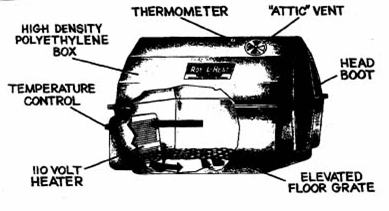



Caring for hypothermic (cold stressed) newborn beef calves
By Ron Torell, Dr. Bill Kvasnicka and Dr. Ben Bruce, University of Nevada-Reno Extension Specialists. First published in a Beef: Questions & Answers" newsletter. Mortality in beef herds from birth to weaning range from three to seven percentThe majority of this occurs within the first 24 hours of life, with slow and difficult births (dystocia) and cold stress (hypothermia) the leading causes of death. As prevention is the best cure, advice for care and treatment of hypothermic or cold stressed calves is given below. We will also review a case study conducted in Elko County, Nev. that examined the use of calf warmers to overcome hypothermia.
Types of hypothermia
There are two types of hypothermia: exposure (gradual) and immersion (acute). Exposure hypothermia is the steady loss of body heat in a cold environment through respiration, evaporation and lack of adequate hair coat, body flesh or weather protection. This type affects all classes of livestock but particularly affects young, old and thin animals.
Immersion hypothermia is the rapid loss of body heat due to saturated hair coat in a cold environment. Immersion hypothermia is often brought on during birth when the calf is born saturated with birthing fluids. Other causes may include being born in deep snow or on wet ground, falling into a creek or being saturated from heavy rains followed by chilling winds.
Symptoms of hypothermia
Faced with a cold environment, the body tries to defend itself in two ways: shivering, to increase muscle heat production, and blood shunting, to reduce heat loss by diverting blood flow away from the body extremities to the body core.
Mild hypothermia occurs as the body's core temperature drops below normal (approximately 100o F. for beef calves). In the early stages, vigorous shivering is usually accompanied by increased pulse and breathing rates. A cold nostril and pale cold hooves are early signs that blood is being shunted away from the body's extremities. In the case of a newborn calf, severe shivering may interfere with its ability to stand and suckle. This sets the calf up for severe hypothermia. Erratic behavior, confusion and clumsiness are all signs of what producers often call "dummy calf." These are signs of mild hypothermia.
 |
|
Figure 1. Roy-L-Heat Calf warming and drying box.
|
Severe hypothermia results as the body temperature drops below 94o F. Shunting of blood continues, manifesting cold and pale nostrils and hooves due to poor oxygenation of the tissues near the body surface. Decreased circulation also results in a buildup of acid metabolites (waste products) in the muscles of extremities. After the shivering stops, it is replaced by muscle rigidity. The pulse and respiration begin to slow as the body core cools to 88oF.
Below core temperature of 94oF. , the vital organs are beginning to get cold. As the brain cools, brain cell metabolism slows, resulting in impaired brain function. The level of consciousness deteriorates from confusion to incoherence and eventual unconsciousness. Below 86oF., signs of life are very difficult to detect and the calf may be mistaken for dead. The pupils of the eyes will be dilated and fixed. The pulse may be undetectable. Occasional gasps of respiration at a rate as low as four or five per minute may be the only clue that the calf is still alive. Heart failure may be the actual cause of death.
Treatment of hypothermia
The immediate concern is returning the calf's core body temperature to normal (100o F. for newborns). Maintaining the normal core body temperature is a secondary objective. For years, producers have used floor board heaters of pickup trucks, submersion of wet calves in a warm bath, placing calves next to the heater in the house, or placing the calf under a heat lamp. Warming and drying boxes have also been used over the years with limited success. Some producers refer to them as "death boxes." Most early warming boxes were a four-foot by three-foot plywood box where the hypothermic calf could be placed to dry and warm. Heat sources were often a heat lamp or propane heater. There was usually no fan to circulate warm air. Ventilation was not considered in construction. As the hair coat dried, the moisture raised the humidity within the box, setting the calf up for pneumonia. Oftentimes, the calf would be left unattended and suffer from heat stress or scorching.
The use of a thermometer is highly recommended. Often, a calf will not appear to be hypothermic. However, upon taking its temperature you may realize that the calf's body temperature is below normal. This is often brought on by dystocia (slow births) which may have put the calf in a hypoxic state (lack of oxygen). A hypoxic calf is slow to dry off and nurse, allowing hypothermia to set in.
Feed the hypothermic calf warm colostrum as soon as possible to speed recovery and increase the probability of full recovery. Breathing the warm air from the calf warmer along with consuming colostrum will warm the calf from the inside out and provide the needed energy to overcome the trauma it just went through.
Case study
Recent design improvements have eliminated the problems of the early handmade warming boxes. In the winter of 1996, three Elko County, Nev. ranchers evaluated the effectiveness of commercial calf warmers for reviving hypothermic calves.
The "ROY-L-HEAT" calf warming and drying box (Figure 1)1 features a 110-volt heater equipped with a circulating fan and automatic shutoff thermostat. The circulating warm air moves under the wet calf (the calf sits on a mesh screen elevated four inches off the floor), up the sides of the calf and is recirculated through the heater. Accumulated moisture escapes through the attic vent. The heater is protected in a separate enclosure attached to the rear of the box and removes easily for simple rinsing and disinfecting. The box is made of high density polyethylene. Its interior size provides adequate space for calves to lay down or stand. Opposite the heater is a rubber "head boot" that permits the calf to breathe outside air when desired, yet holds the warm air in at all times.
Cooperator Barry Anderson of Ruby Valley replaced the heater and fan on his calf warmer with a 12-volt RV heater. Barry powers the heater and fan with a 12-volt RV battery. The RV battery provides extended life over a regular 12 volt car battery.
"By using the 12 volt system, I can take the calf warmer right to the hypothermic calf in the field. The cow stays close by because she can smell the calf in the box as it dries off. Oftentimes when I return to check on the calf it has removed itself from the box, nursed and left with its mother," said Anderson.
Cooperator Ed Sarman, owner and manager of Lee Livestock in Lamoille, Nev., uses the heat box predominately with his first-calf heifers.
"We calve our heifers in late February, one heat cycle prior to the mature cow herd," he said. "The delayed delivery often associated with heifers and lack of experience to lick the calf and stand to let it nurse, all contribute to the increased incidence of hypothermic calves in our first-calf heifers. The calf warming box saves us time and labor. We place the cold calf in the box and are able to go on and do other things while the calf recuperates. We used to have to babysit the calf for fear of scorching. We find ourselves placing mild hypothermic calves that we used to let recuperate on their own at a slower pace, in the box for a short period of time. Getting the edge off of these slightly-stressed calves gets them off to a better start."
Cooperator Tom Barnes of Jiggs, Nev. collected data on a few of the hypothermic calves he treated with the heat box.
"I was impressed with the recovery of one calf in particular," says Barnes. "I found this calf at 1 a.m. on Feb. 27. There were six inches of frozen snow on the ground and it was 10oF. This calf was flat out. His body temperature was 86oF. I tubed the calf with warm colostrum and placed him in the warmer for six hours. This calf, from a first-calf heifer, weaned off at 500 pounds this fall. I know he would have died if I had not had the calf warmer."
Conclusion
Severe hypothermic calves can be revived and saved. However, they often are set back from the experience, and their body defense system can be compromised. This sets the calf up for pneumonia, scours and other calfhood problems. The incidence and severity of hypothermic calves can be reduced through preventative measures. A separate paper on preventing hypothermia in beef calves is available by calling 702-784-1624.
Footnote
1ROY-L-HEAT calf warmer is manufactured by Smucker Manufacturing, Inc., 22919 N. Coburg, Harrisburg, Oregon 97446 (800-333-4503). Reference to a company or trade name does not imply approval or endorsement by the University of Nevada, Reno or by the Montana State University Extension Service.
February 2008


